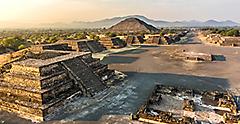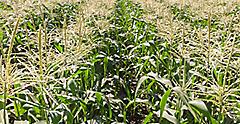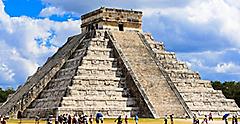The Mayan Maize God: Corn's Sacred Role in Ancient Culture
Fun Facts About Mayan Culture
By Claire Heginbotham | Published on November 20, 2025
Thousands of years ago (before the invention of the wheel!), the Mayan people developed the thriving Maya civilization, and their innovations in technology, architecture and agriculture allowed them to quickly evolve and grow. They started to experiment with the cultivation of crops, and they worked out that they could cultivate corn. This changed everything, as it meant they could settle down from their nomadic lifestyle and build the incredible society that still endures today.
The culture of the Mayans was heavily influenced by corn; it impacted everything from religion to astrology and rituals such as marriage ceremonies and burial ceremonies. And in Mexico today, the legacy of corn can be tasted in every home-cooked tortilla.
Key Takeaways: The Mayan Maize God and Mayan Corn
- ● Corn is an inextricable part of culture in Mexico, and was a key crop in the Mayan era.
- ● The Mayan creation myth involves humans being made out of corn-based dough by the gods.
- ● Hun Hunahpu, the Mayan maize god, is a central figure in the Mayan religion, with his worship tied to the harvest cycle.
- ● Explore our cruises to the Mayan coast of Mexico to engage with ancient Mayan culture, as well as its modern echoes in contemporary Mexico.
The History Behind Mayan Corn

Back in 10,000 B.C., corn — also known as "maize" or "el maíz" — was wild-growing and undomesticated. It was a far cry from the yellow cobs of corn we're used to slathering in butter during a summer barbecue. Corn, to the ancient Mayans, was boiled with white lime to soften it, then ground into a paste to form a dense dough before being eaten.
The geographical imprint of wild corn stretches across Mesoamerica (Central Mexico, Belize, Guatemala, El Salvador, Honduras, Nicaragua and Northern Costa Rica). While other Mesoamerican civilizations eventually cultivated corn, the ancient Mayans had the earliest impact in this part of the world. They developed vast cornfields around their carefully constructed stone cities, hand-selecting the best seeds to begin the slow domestication process (the first form of genetic engineering).
Corn And The Mayan Religion: The Maize God

The Popol Vuh is a sacred text written by the Mayans that details the origin of humankind. It tells a story that the Mayan gods first tried to form humans out of mud and then out of wood. When those two attempts failed, they created the first human from a dough of yellow and white corn — and thus the Mayan people's complex and reverent relationship with corn began.
To the Maya, gods represent nature, society and various professions. Mayan culture spoke of a god called Hun Hunahpu, the Mayan god of maize. It's believed that the Mayan corn god was decapitated during harvest time and reborn at the start of the next growing season, so he not only represented corn, but he also represented the cycle of seasons and the promise of a new harvest each year.
Hun Hunahpu was depicted at various stages of life in art to represent the fact that he grew, died and was reborn alongside the annual harvest. His distinctive icon was his hair and headdress, which together resemble corn. In addition to his own important role, tales from the Mayan culture religion name him as the father of the Hero Twins of Mayan mythology. Their mother, Xquic, became pregnant with the twins upon touching the severed head of Hun Hunahpu.
The Maya performed rituals to worship the maize god at various stages of corn growth, especially during periods of drought. While there's no record of human sacrifice to this god, there were "bloodletting" sacrifices where nobles pierced their skin to smear blood on a statue to ensure the new crop.
The Value Of Corn In Mexican And Mayan Culture
Like most successful civilizations, the Mayan people were a nation of farmers. Mayan agriculture provided food for their families and a commodity to trade with other peoples. The Mayans are universally renowned by modern historians for developing technology far beyond what was happening elsewhere at the same time.
Mayan farmers dutifully created neat terraces on the side of volcanic mountains, working hard to reclaim land from the forests and raise fields from swamps. They built reservoirs to conserve water and irrigation canals to encourage their crops to grow. And they even went so far as to create fertilizer from the aquatic plants and sediments that naturally occurred in their canals.
They also cultivated beans, squash and fruit trees, but they valued corn over other grains because crops of corn were typically easy to grow, thriving in dry or wet conditions, and they naturally grew better after being cut down in harvest. Like other staple crops worldwide, corn was high in carbohydrates, which meant energy to the Mayans, and could be stored over long periods without spoiling.
Corn and the Ancient Climate
Paleoclimatologists discovered that during the Classic Period of the Maya culture (250 A.D. – 950 A.D.), the region suffered severe droughts and climate change, making the longevity of corn even more important. However, recent studies also show the high demand for corn may have depleted the environment, making the area more susceptible to drought.
In its prime, some 1,000 years ago, Chichen Itza was the biggest city in the Yucatan Peninsula. Once home to tens of thousands of Maya people, it was sacred to the Maya and was the center of their empire. They built it according to the location of the sun, and it was likely where ton upon ton of corn was processed, traded and consumed. Today, those looking to visit Chichen Itza will find that it lies in majestic Mayan ruins that you can explore on foot with Chichen Itza tours. It's considered one of the "New Seven Wonders of the World."
Corn and Ancient Mayan Astronomy
Mayans are famous for developing sophisticated calendars based on astronomical events. Astronomy was mainly used by the Mayan priests to understand the past and project the future, creating prophecy. But the ancient Mayans were an incredibly ritualistic people and lived by a 260-day ceremonial calendar that connected directly to the time it takes their corn crops to mature.
The sun was a key symbol in their culture; farmers cleverly devised an agricultural calendar based on their accurate calculation of a 365-day solar year. The mathematical calculations made to predict astronomical systems were surprisingly accurate and could even predict the time of sunrise and sunset.
The Importance Of Corn In Mexico Today
Nowhere in the world can you find such an age-old, intimate connection with corn as you can in Mexico. Corn still holds deep cultural meaning to the people of Mexico today, and it's a symbol of Mexican pride.
It's a thread in the cultural tapestry of Mexican culture, connecting generation to generation for around 10,000 years. It's the basis of numerous meals and a source of income for many families. But the country's traditional, colorful heirloom corn is in peril due to the agriculture of corn in other countries. The golden corn that is eaten and grown in the U.S. has made Mexico's corn less of a commodity.
Authentic Mexican corn has a delicious, rich flavor. If you find yourself in Mexico City, head to the tortilleria called Maizajo to see what heirloom corn looks like and pick up a stack of chips, tortillas, tostadas and more. This rustic store is helping to preserve Mexican heritage for future generations by preserving lesser-known species of corn that are in danger of going extinct. You can taste Maizajo's produce at over 70 restaurants in Mexico City, too.
To Mexicans, corn is "the food with which the gods chose to feed mankind." Thanks to those ancient Mayan farmers, you'll find corn on the dinner tables of Mexico to this day.
Visiting a Land Where Corn Is Part of Culture

When you visit Mexico City or Chichen Itza and have a delicious meal made with corn, you're not just sampling a local delicacy; you're engaging with thousands of years of history. From the era of harvest entreaties to Hun Hunahpu to today's fight to keep Mexican corn culture alive, this is a formidable tradition.













